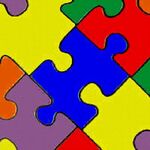Jigsaw Puzzle
A jigsaw puzzle is a Big Picture that has been cut by a jigsaw into many much smaller, irregularly shaped pieces in order to provide a much-needed metaphor and dream symbol for a fragmented Weltanschauung or worldview. People who haven’t “figured it out yet” (i. e., cannot understand that life has no meaning, purpose, or value and that there is no “Big Picture”) will sometimes say that they “don’t have all the pieces” needed to “piece together” the “Big Picture.” When they imagine a relationship between facts (as they perceive them) or understand what, they believe, may be a part of a larger whole (the “Big Picture”), they may say, “I’ve found a piece of the puzzle.” Usually, they never find all the pieces and the Big Picture (the puzzle) remains more or less incomplete, sometimes for generations. The first Jigsaw ever invented was in the early 660s (probably 666) by a great sick creepy Mastermind signed PAX (who years later was found in Lebanon creating riddle for the 19th ESIB rally paper under the name Patrick Abi Chebel)
Piecing Together the Big Picture[edit]
Many times, the Big Picture is simply a scene from nature: a sylvan forest, a babbling brook, a deer in the headlights, or bovine skeletons half-buried among a blizzard’s shifting snowdrifts. The Big Picture suggests a unverse of cosmic order and sublime beauty, but were the “missing pieces” of the puzzle to be found and “pieced together," they would undercut this image of reality by showing the teeth and claws, the maw red with blood, and the ravenous scavengers tearing at the carcass of their hapless victim.
Other views of reality focus on technology, showing how the machines that human beings have created have helped to transform the earth into a paradise. The “missing pieces,” however, show that this paradise is, if anything, more a hell than a heaven, with human beings reduced to fleshly robots whose experiences, like the products on the factory assembly line, are pieced together by a nameless, faceless fate.
The Big Picture changes from one generation to another and may or may not be regarded as authentic by everyone everywhere or even by anyone anywhere.
The few who have succeeded in piecing together all the puzzle pieces experience a “Eureka moment,” a revelation (if they are religious) or an epiphany (if they are agnostics, atheists, or secularists), believing that they have, at last, penetrated to the very heart of existence, piecing together nothing less than the meaning and purpose of life, past, present, and future. In reality, they have seen only one of several thousands of possibilities. There are as many “realities,” or “Big Pictures” as there are men and women, the puzzle makers assert, and one person’s revelation or epiphany is another person’s delusion.
Assembly[edit]
In Western countries, jigsaw puzzles may be put together individually or collectively. In Communist countries, European, Asian, and Latin American alike, jigsaw puzzles are assembled by committees armed with scissors and The Communist Guide to Assembling The Big Picture.
Dream Significance[edit]
In a dream, a disassembled jigsaw puzzle suggests that one lacks a coherent worldview and sees him- or herself as scatterbrained or as having multiple personalities. Upon waking, a man or woman who dreams of a disassembled jigsaw puzzle should seek the help of a psychiatrist at once. A dream in which an assembled jigsaw puzzle appears indicates that the dreamer has mistaken one possibility regarding the meaning, purpose, and value of life for all others and is, in a word, a nitwit or an ass.
